Dreaming of silky noodles cloaked in vibrant red sauce or a pizza that tastes like it came straight from Naples? Mastering how to make tomato sauce at home gives you that authentic flavor—no hidden preservatives, just ripe tomatoes simmered with aromatic garlic, herbs, and a hint of spice. This quick guide walks you through transforming everyday produce into a customizable cornerstone for pastas, casseroles, and beyond, ensuring every spoonful reflects your personal touch.
Print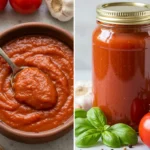
Homemade Tomato Sauce Recipe
- Total Time: 50 minutes
- Yield: 4 cups (serves 4-6)
- Diet: Vegan
Description
This homemade tomato sauce is rich, flavorful, and easy to make. Made with fresh tomatoes, aromatic herbs, and a hint of olive oil, it’s perfect for pasta, pizza, or as a base for many dishes. Unlike store-bought versions, this sauce is free from preservatives and artificial ingredients, offering a fresh and healthy alternative.
Ingredients
- 2 lbs (900g) Roma or San Marzano tomatoes, fresh, peeled, and chopped
- 2 tbsp extra virgin olive oil
- 1 small onion, finely chopped
- 3 cloves garlic, minced
- 1 tsp salt (adjust to taste)
- ½ tsp black pepper
- 1 tsp dried oregano
- 1 tsp dried basil
- ½ tsp red chili flakes (optional, for spice)
- 1 tbsp tomato paste (for depth of flavor)
- ½ tsp sugar (optional, to balance acidity)
- ½ cup water or vegetable broth (adjust for desired consistency)
- 1 tbsp balsamic vinegar or red wine (optional, for richness)
- Fresh basil leaves, for garnish
Instructions
Prepare the Tomatoes:
- If using fresh tomatoes, blanch them by boiling for 30 seconds, then transferring to an ice bath. Peel and chop them.
Sauté the Aromatics:
- Heat olive oil in a large saucepan over medium heat. Add chopped onions and sauté until soft (about 5 minutes).
- Stir in minced garlic and cook for another 1-2 minutes until fragrant.
Build the Flavor Base:
- Add tomato paste and cook for 1 minute, stirring continuously.
- Stir in the chopped tomatoes, salt, black pepper, oregano, basil, and red chili flakes (if using).
Simmer the Sauce:
- Add water or broth, then bring to a gentle simmer. Reduce heat to low and cook uncovered for 30-40 minutes, stirring occasionally.
- If using balsamic vinegar or red wine, add it in the last 10 minutes of cooking.
Blend and Adjust:
- For a smooth sauce, use an immersion blender or transfer to a blender in batches.
- Adjust seasoning with more salt, sugar, or herbs as needed.
Serve or Store:
- Garnish with fresh basil and serve warm over pasta, pizza, or any dish of choice.
- Store leftovers in an airtight container in the refrigerator for up to 5 days or freeze for up to 3 months.
Notes
- Canned Tomatoes: If fresh tomatoes are unavailable, substitute with 28 oz (800g) canned whole tomatoes.
- Chunky vs. Smooth: Blend for a smooth texture or leave it chunky for a rustic feel.
- Storage Tip: Freeze in small portions for easy use in future recipes.
- Prep Time: 10 minutes
- Cook Time: 40 minutes
- Category: Sauce
- Method: Simmered
- Cuisine: Italian
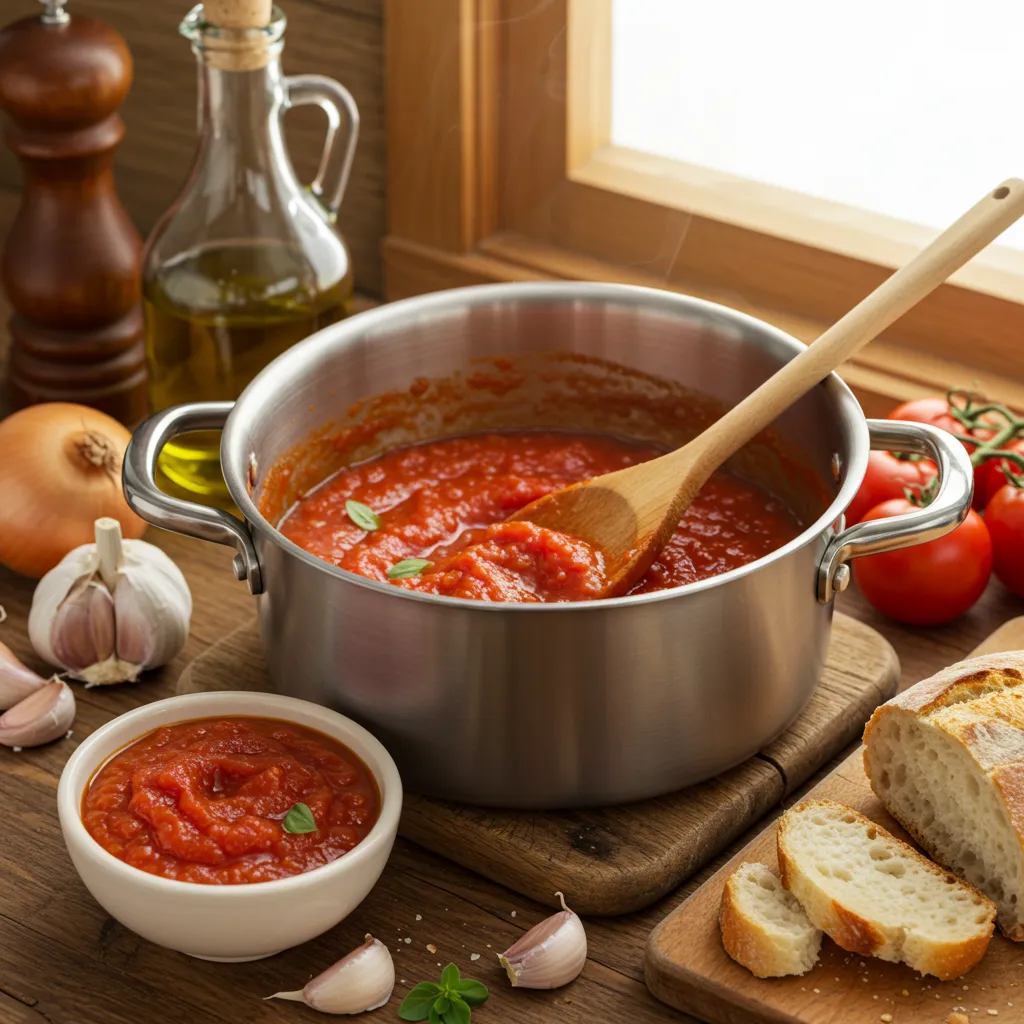
Why Make Homemade Tomato Sauce?
Mastering tomato sauce at home unlocks flavor freedom. Homemade tomato sauce delivers brighter taste and endless flexibility—you decide whether to double the garlic or sprinkle fragrant basil and oregano. Unlike store-bought versions, your homemade sauce stays pure, free from preservatives and artificial additives.. Adjust texture, spice, and sweetness to match any meal, turning humble tomatoes into a personal signature every time you lift the lid.
Another perk of DIY sauce is total control over thickness, sweetness, and heat—go chunky for hearty stews or blend it silky-smooth for pasta and pizza. Making tomato sauce at home also trims grocery costs during tomato season and reduces food waste by using every part of the fruit, much like. what a classic Caesar salad contains maximizes its ingredients.
Ingredients You’ll Need

Assemble these key ingredients to craft a vibrant, flavorful homemade tomato sauce:
- Fresh Tomatoes: Choose Roma or San Marzano for built-in sweetness and minimal juice. When peak tomatoes are out of reach, a trusted can of whole plum tomatoes is an excellent backup.
- Garlic & Onion: This aromatic duo lays the flavor foundation. When learning how to make tomato sauce at home, choose yellow onions for mellow sweetness and red onions for a sharper, more robust kick.
- Herbs & Seasonings: Basil, oregano, thyme, and parsley deliver classic Italian notes. Fresh leaves brighten; dried versions contribute slow-cooked depth.
- Olive Oil: A hearty drizzle of extra-virgin olive oil adds richness and a smooth, velvety texture.
- Optional Boosters: A pinch of sugar tempers acidity; crushed red pepper introduces heat. A brief pour of red wine or a drizzle of balsamic vinegar deepens the sauce with gentle, layered complexity. With these pantry staples on hand, you’re primed to effortlessly simmer a sauce that tastes garden-fresh, costs little, and minimizes waste.
Adding vegetables such as carrots or celery introduces gentle sweetness and layered flavor to your sauce. When picking side dishes for your tomato sauce, consider [how to make mustard at home]—its lively tang provides the perfect counterpoint, turning an ordinary plate into something unforgettable.
Tools and Equipment
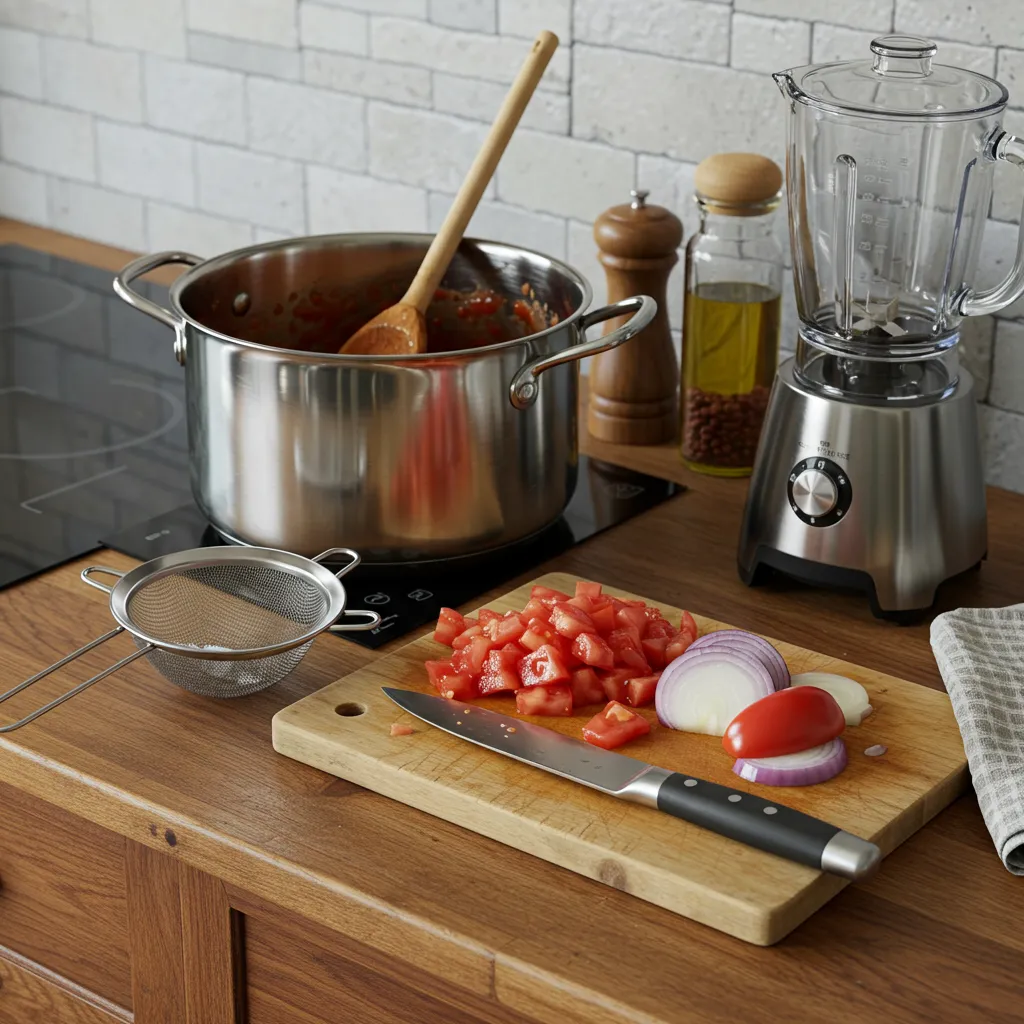
Having the right gear makes tomato sauce prep easy:
- Blender or Food Processor: Delivers a velvety blend; skip it for countryside-chunky texture.
- Large Pot or Saucepan: Provides steady heat and plenty of room for slow simmering.
- Fine Strainer or Sieve: Removes skins and seeds to polish the sauce.
- Sharp Knife and Reliable Cutting Board: Speeds through fresh tomato and onion prep with safety.
- Wooden Spoon: Lets you stir for hours without scratching precious cookware.
Step-by-Step Guide to Tomato Sauce
If you’ve ever wondered how to make tomato sauce at home, the process starts with selecting the best tomatoes and preparing a rich, flavorful base.
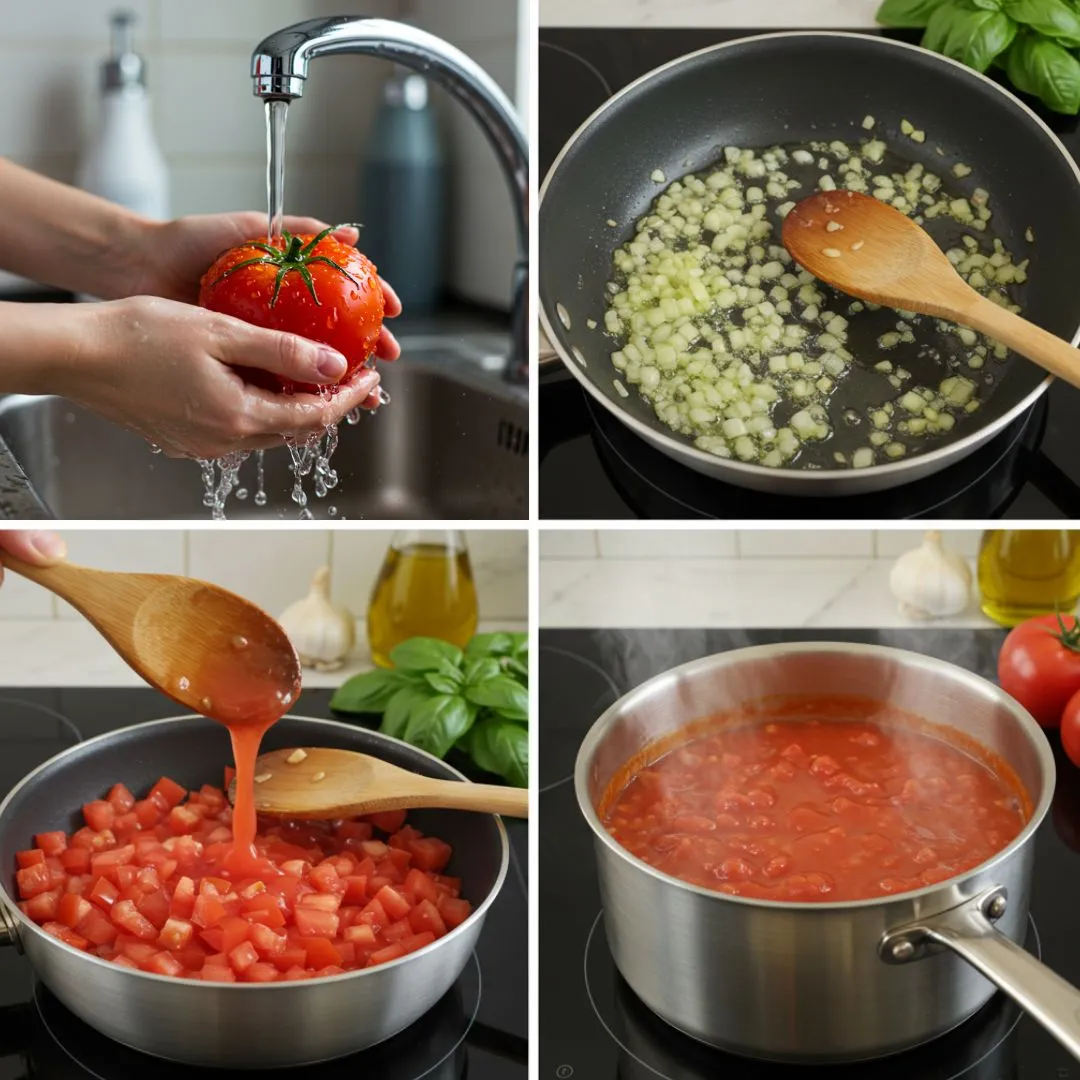
Prepping Tomatoes
Rinse ripe tomatoes under cool water, slice away the cores, and score the skins. For a silky result, drop them into boiling water for half a minute, shock in ice water, slip off the peels, then quarter; reserve seeds only if you like extra texture.
Building Flavor
Warm a splash of extra-virgin olive oil in a sturdy pot set over medium heat. Cook finely chopped onion until glossy, about five minutes, then stir in minced garlic for a fragrant minute more. Patience here unlocks sweetness.
Combine & Simmer
Tumble in the tomatoes—or quality canned ones with their juices—then season with sea salt, cracked pepper, and a touch of sugar or grated carrot to soften acidity. Dust in crushed red pepper for gentle heat, bring the pot to a lazy simmer, lower the flame, and let it burble for 30–40 minutes, stirring occasionally. If the sauce becomes too thick, stir in a splash of water or broth until it gently clings to the back of a spoon
Follow these steps once and you’ll never reach for store-bought tomato sauce again.
Storage Tips
When you master homemade tomato sauce, you control storage and preservation. Portion and keep it your way, so a batch of fresh, house-made goodness is always ready when cravings strike.

Refrigeration:
Spoon hot tomato sauce into airtight, food-safe jars, let it cool to room temperature, then refrigerate; the sauce stays fresh for up to one week or so.
Freezing:
For longer keeping, ladle cooled tomato sauce into flat freezer bags or rigid containers, leave headspace, label with the date, and freeze; properly sealed portions keep flavor for six months.
Canning:
For shelf stability, sterilize jars and lids, fill with bubbling tomato sauce, wipe rims, seal, and process in a boiling-water bath for 20 minutes. Store cooled jars in a dark pantry; test each lid the next day—any flex means refrigerate and use within a week. Done right, canned tomato sauce stays tasty for a year. Learn more on homemade mayonnaise safety.
Enhance Your Tomato Sauce
Enhance your tomato sauce with these flavor-boosting ideas:
- Roast the Tomatoes: Oven-roasting concentrates sweetness and adds gentle smokiness.
- Add a Parmesan Rind: Let a rind simmer in the pot so its umami richness melts into the tomato sauce.
- Deglaze with Wine: A quick splash of red or white wine deepens complexity while lifting flavorful browned bits.
- Mix in Extra Veggies: Blend roasted red peppers or sun-dried tomatoes into the sauce for a rich, earthy layer of flavor.
Mix and match these upgrades until the flavor is unmistakably yours.
Pairings and Variations
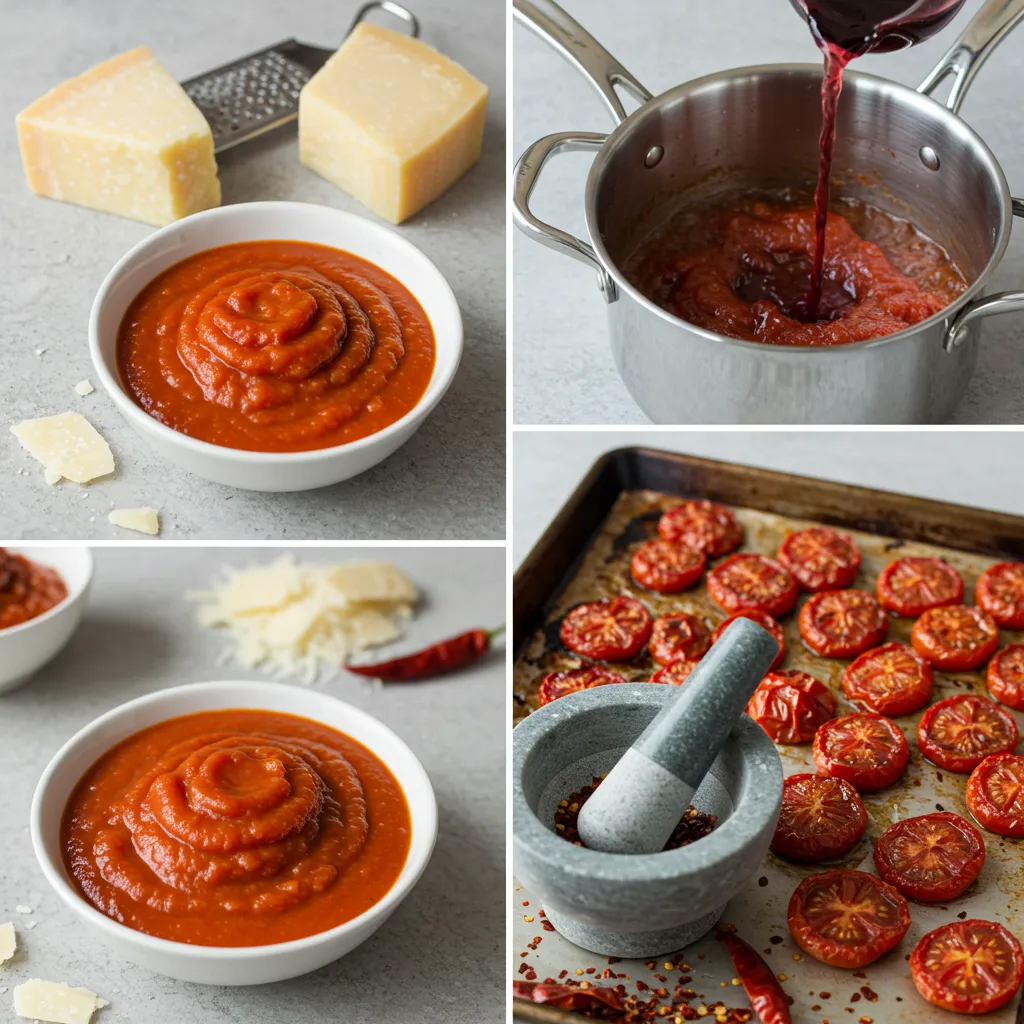
Tomato sauce shines across countless dishes—ladle it onto pasta, spread it over pizza dough, or offer it as a breadstick dip. For a lighter pairing, spoon a little alongside a crisp Greek salad for bright contrast and fresh flair.
When you crave something richer, turn tomato sauce into a quick Bolognese by browning ground beef or pork in the pot. For indulgent creaminess, swirl in heavy cream or mascarpone. Prefer heat? Double the red-chili flakes or stir through diced fresh chilies for a bold kick.
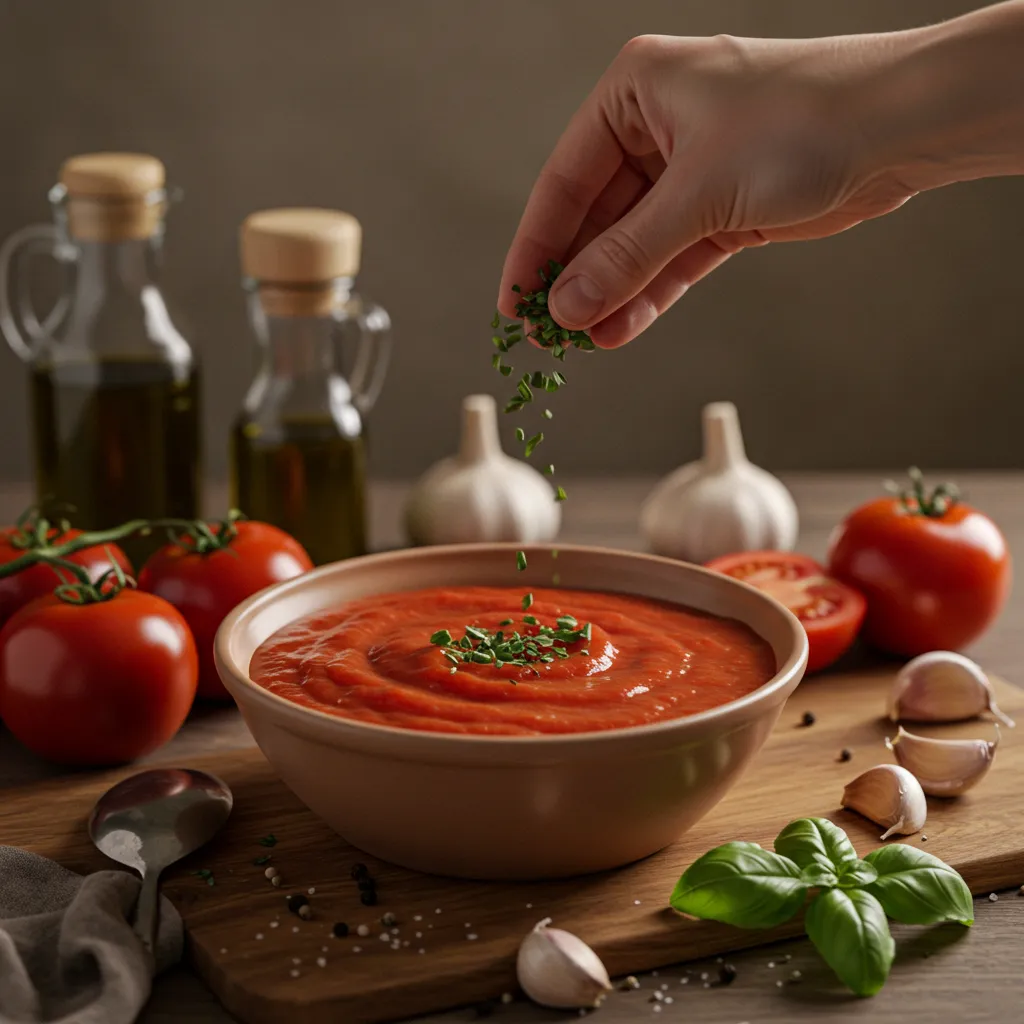
Health Benefits of Tomato Sauce
- Rich in Antioxidants – Tomato sauce brims with lycopene, a potent antioxidant linked to lower risks of certain cancers and chronic diseases. Learn more about lycopene’s benefits.
- Supports Heart Health – Lycopene and potassium in tomato sauce may help reduce blood pressure, cut cholesterol, and guard against heart disease.
- Boosts Immunity – Vitamin C and beta-carotene in tomato sauce strengthen defenses, while antioxidants tame inflammation.
- Enhances Skin – Lycopene helps shield skin from UV rays, improving elasticity and hydration.
- Aids Digestion – Tomato sauce supplies dietary fiber that encourages healthy gut motility and balanced microbiota.
- Protects Vision – Lutein and zeaxanthin in tomatoes safeguard eyes from blue-light damage and age-related macular degeneration.
- Supports Weight Goals – Tomato sauce is nutrient-dense yet low in calories, adding big flavor without excess fat or sugar—ideal for weight-management plans
- Supports Bone Strength – Tomato sauce delivers vitamin K and calcium, nutrients that help maintain solid bones and may guard against osteoporosis. Discover how tomatoes fortify bone health—their vitamin K directs calcium into bones, while antioxidants curb inflammation that weakens the skeleton. Dive deeper in on WebMD.
FAQs About Tomato Sauce
Can I use canned tomatoes when fresh ones aren’t available?
Absolutely—choose high-quality canned plum tomatoes, such as San Marzano, for consistent flavor and body.
How do I thicken tomato sauce?
Simmer the pot uncovered until excess liquid evaporates, or stir in a spoonful of tomato paste for quick richness.
What’s a natural way to balance acidity?
Grated carrots or slow-caramelized onions lend gentle sweetness without refined sugar.
How long does homemade tomato sauce keep?
In an airtight container, it stays fresh five to seven days in the fridge and up to six months in the freezer.
Do I have to peel the tomatoes?
Peeling is optional; skins can taste slightly bitter, but a quick blend all but erases their texture.
Making tomato sauce at home is simple, customizable, and rewarding—experiment freely and enjoy a batch that’s entirely your own.

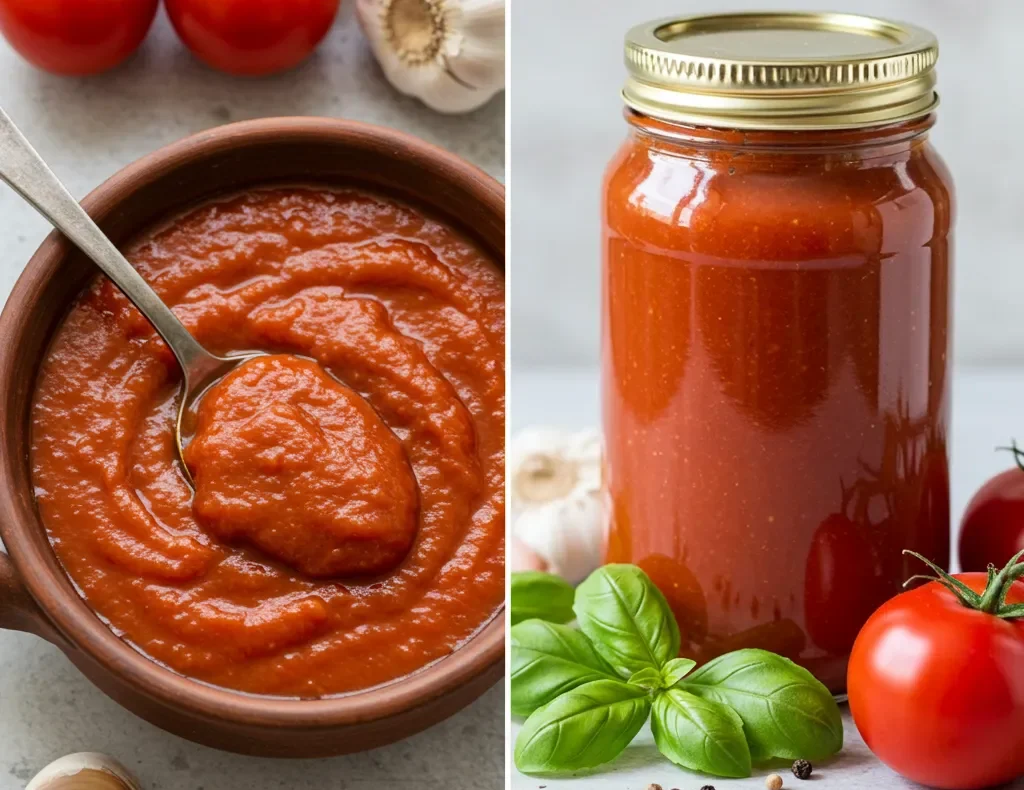
7 thoughts on “How to Make Tomato Sauce at Home?”